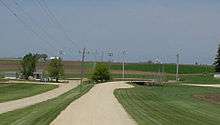Pop-culture tourism
Pop-culture tourism is the act of traveling to locations featured in popular literature, film, music, or any other form of media. Also referred to as a "Location Vacation".
Popular destinations have included:
- Los Angeles, California area film studios
- New York City, New York urban area featured in hundreds of Hollywood and American films.
- The Field of Dreams, a baseball field featured in the movie of the same name
- New Zealand after The Lord of the Rings was filmed there
- Sherwood Forest, Nottinghamshire, associated with Robin Hood
- Alnwick Castle, location of Hogwarts in Harry Potter
- Rosslyn Chapel, Scotland and Lincoln Cathedral, England. Locations used in The Da Vinci Code film
- Wallace Monument, Stirling, dedicated to Scottish hero William Wallace. Saw a visitor rise of 160,000 after the film Braveheart
- Loch Ness in the Scottish highlands, home of the mythical Loch Ness Monster
- Highclere Castle, location of Downton Abbey
- Stratford-upon-Avon, birthplace of William Shakespeare, receives about 4.9 million visitors a year from all over the world.[1]
- Tintagel Castle in South-West England, association with King Arthur
- Ashdown Forest, East Sussex, setting for Winnie-the-Pooh. The game Poohsticks is a popular attraction.
- Tom's Restaurant which is known to many as Monk's from Seinfeld
- Prince Edward Island, in which the Canadian novel Anne of Green Gables takes place, is a popular attraction for tourists, notably from Japan.
- South Korea because of the recent Hallyu phenomenon in East Asia.
- Japan for japanophiles or lovers of Japanese pop-culture.
- Istanbul for fans of Turkish television drama.
- Forks, Washington, primary setting of the Twilight series of novels and films.
- North Bend, Washington and in particular Twede's Cafe where much of the television show Twin Peaks was shot.
- Roslyn, Washington, which stood in for Cicely, Alaska in the television show Northern Exposure.
- Tunisia, location of the filming of the Star Wars movies.
- Pin Oak Court, Vermont South, Victoria, a suburban Melbourne shooting location for internationally popular soap opera Neighbours
- Santa Ynez Valley in Central California where much of Sideways took place.
- Burkittsville, Maryland, where tourists re-create the most gruesome scenes from The Blair Witch Project.
- Salzburg, Austria, where many scenes from the musical The Sound of Music were filmed.
- Metropolis, Illinois, declared by DC Comics to be the home of Superman.
- Liverpool, for fans of The Beatles. A museum dedicated to them 'The Beatles Story' is situated at the Albert Dock. The reconstructed 'Cavern', the club they played in before becoming famous is also a stop for Beatles pilgrims. A bus tour of the city entitled The Magical Mystery Tour, visits many sites associated with the group including former homes of The Beatles.
- Tobermory, Isle of Mull, Scotland, Location of the popular children's programme Balamory
- Albuquerque, New Mexico. The location of the AMC television series Breaking Bad.
- Brevard and Transylvania County, North Carolina. Filming location of The Hunger Games (film).
- Petra, Jordan, where visits went from the thousands to the millions after the climactic scene of Indiana Jones and the Last Crusade was filmed in Al Khazneh.[2]
- Norway, where tourism increased after the Pixar movie Frozen was released
Pop-culture tourism is in some respects akin to pilgrimage, with its modern equivalents of places of pilgrimage, such as Elvis Presley's Graceland and the grave of Jim Morrison in Père Lachaise Cemetery.
Another pop-culture tourism destination is Vulcan, Alberta Canada. In the early 1990s this small rural community began to explore ways it could capitalize on the coincidence of the Town's name being the same as popular Star Trek Character, Mr. Spock's home planet: Vulcan, to develop its local tourism industry.
See also
External links
- Stephen Metcalf, Pop Culture Trips, Travel + Leisure Magazine, May 2006 (article about pop-culture tourism).
References
- ↑ "Stratford District Council Report - Controlling the location, scale and mix of development" (PDF). Retrieved 2013-05-31.
- ↑ Comer, Douglas (2011). Tourism and Archaeological Heritage Management at Petra: Driver to Development Or Destruction?. Springer. pp. 5–6. ISBN 9781461414803. Retrieved July 17, 2014.
This article is issued from Wikipedia - version of the 10/19/2016. The text is available under the Creative Commons Attribution/Share Alike but additional terms may apply for the media files.
